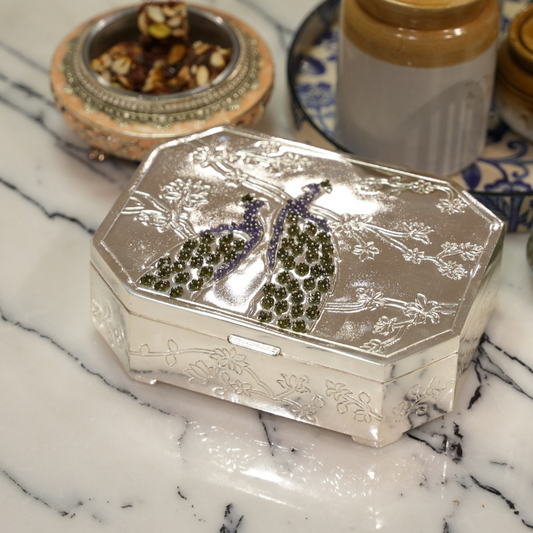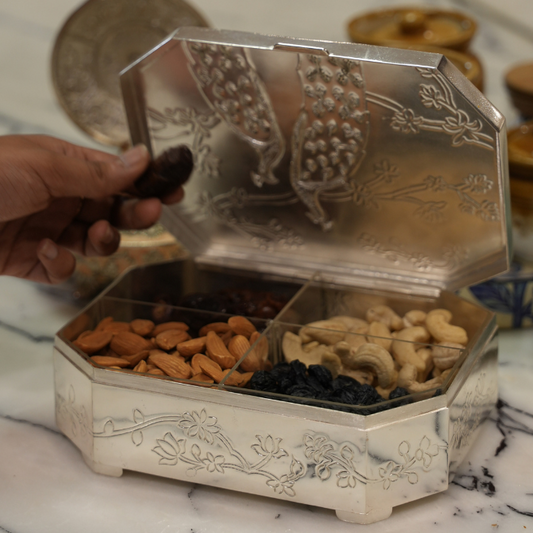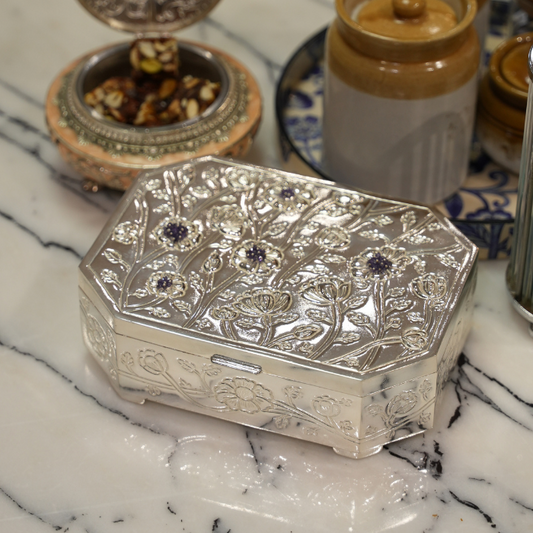Understanding Pure Silver Plates: Purity, Value, and Why They Stand Out
The timeless elegance of a pure silver plate has captivated generations. Whether it graces a dining table or is gifted during special occasions, its shine and value are unmatched. But how can you distinguish a pure silver plate from a silver-plated one or sterling silver plate? This comprehensive guide will help you understand purity in silver plates, their investment value, and why pure silver dinner sets are becoming a luxurious trend in modern households.
What is a Pure Silver Plate?
Definition and Composition
A pure silver plate typically consists of 99.9% silver, also marked as "999". This level of purity sets it apart from sterling silver plates, which contain 92.5% silver and 7.5% other metals, usually copper to improve hardness and durability. While sterling silver is more resistant to scratches, pure silver plates are prized for their unmatched luster and authenticity.
The Allure of Pure Silver Plates
Silver has been a symbol of wealth, purity, and grace for centuries. In many cultures, a pure silver plate is used in religious ceremonies, weddings, and traditional functions. Owning or gifting a pure silver dinner set signifies elegance, prosperity, and timeless beauty.
Purity Levels and Markings on Silver Plates
Understanding Purity Levels
Silver purity is indicated through hallmarking. A purity silver plate with a "999" stamp means it’s made of 99.9% silver is considered the purest form. A "925" hallmark indicates a sterling silver plate, which is still high-quality but not entirely pure.
Common Hallmarks on Pure Silver Plates
Look for clear stamps like:
-
999 – Pure silver
-
925 – Sterling silver
These hallmarks are usually accompanied by a BIS or manufacturer’s stamp in many regions. Spotting these can help you avoid silver-plated or counterfeit items.
Sterling Silver vs. Pure Silver Plates
Key Differences
-
Composition: Pure silver plates = 99.9% silver; sterling silver plates = 92.5% silver + 7.5% alloys.
-
Appearance: Pure silver has a brighter shine; sterling silver is slightly duller but more durable.
-
Price: Pure silver is more expensive due to its higher silver content.
Pros and Cons
-
Pure Silver Plate
-
Pros: Superior shine, higher value, ideal for investment and gifting.
-
Cons: Softer, more prone to scratches.
-
Sterling Silver Plate
-
Pros: More durable and affordable.
-
Cons: Lower purity and can tarnish faster due to alloys.
The Growing Popularity of Silver Dinner Sets
Silverware in Modern Dining
From high-end hotels to luxury homes, the pure silver dinner set is making a comeback. These sets add sophistication to festive occasions, weddings, and upscale dining experiences.
Benefits of Using Silver Dinner Sets
-
Antibacterial: Silver’s natural properties make it hygienic.
-
Sustainability: Long-lasting and eco-friendly compared to disposable or low-quality dinnerware.
Customization and Gifting
Custom-engraved pure silver plates and sets are becoming a popular gift for weddings, anniversaries, and corporate milestones combining tradition with personalization.
Caring for Your Pure Silver Plate
Cleaning and Maintenance
To maintain the shine of your pure silver plate:
-
Use mild cleaning solutions like baking soda and vinegar.
-
Gently polish with a silver-cleaning cloth.
-
Avoid abrasive cleaners that can scratch the surface.
Storage Tips
-
Store in anti-tarnish cloth or pouches.
-
Use silica gel to reduce humidity.
-
Wrap each plate separately to prevent scratching.
Handling Recommendations
Handle with clean hands or gloves to avoid oils and dirt. For vintage or heirloom pieces, minimize direct handling to preserve long-term value.
How to Verify the Authenticity of a Pure Silver Plate
Professional Testing Methods
-
Acid Test: Common in jewelry stores, this checks how silver reacts to specific chemicals.
-
X-Ray Fluorescence (XRF): A precise, non-destructive method for verifying purity.
Home Testing Techniques
-
Magnet Test: Silver is non-magnetic.
-
Ice Test: Silver has high thermal conductivity, that is, ice melts quickly on its surface.
Understanding Hallmarks and Certificates
Always purchase from certified sellers who provide:
-
Proper hallmark stamps (e.g., “999”).
-
Authenticity certificates.
-
Documentation of purity and origin.
Investment Value of Pure Silver Plates
Longevity and Market Value
A pure silver plate isn’t just tableware, it’s an asset. With rising silver prices, these plates offer long-term investment value, especially compared to items like coins and jewelry that may have limited use.
Antique and Vintage Pure Silver Plates
Collectors often pay a premium for antique or vintage plates, especially those with antique silver markings or unique vintage silver hallmarks.
Silver vs. Other Precious Metal Investments
Compared to gold and platinum, silver is:
-
More affordable
-
Easier to liquidate in smaller units
-
Versatile in utility (dining, decor, gifting)
Conclusion
A pure silver plate brings more than just aesthetic charm, it offers cultural richness, practical benefits, and financial value. Whether you’re investing, dining, or gifting, understanding the difference between pure silver and sterling silver plates, recognizing hallmark purity, and learning care techniques ensures that your investment stands the test of time.
FAQs
Q1: What is the difference between pure silver plates and sterling silver plates?
A1: Pure silver plates are 99.9% silver, while sterling silver contains 92.5% silver mixed with alloy metals like copper.
Q2: How can I verify the authenticity of a pure silver plate?
A2: Look for a “999” hallmark, test with a magnet or ice, or seek professional testing like XRF analysis.
Q3: Are pure silver plates suitable for daily use?
A3: Yes, with proper care and regular cleaning, they are perfect for both display and use.
Q4: Why are pure silver dinner sets popular?
A4: They offer luxury, health benefits, and sustainability, making them ideal for modern households and special occasions.
Q5: How should I care for pure silver plates?
A5: Clean gently, store in anti-tarnish cloth, and keep away from chemicals and humidity to preserve their beauty and value.







